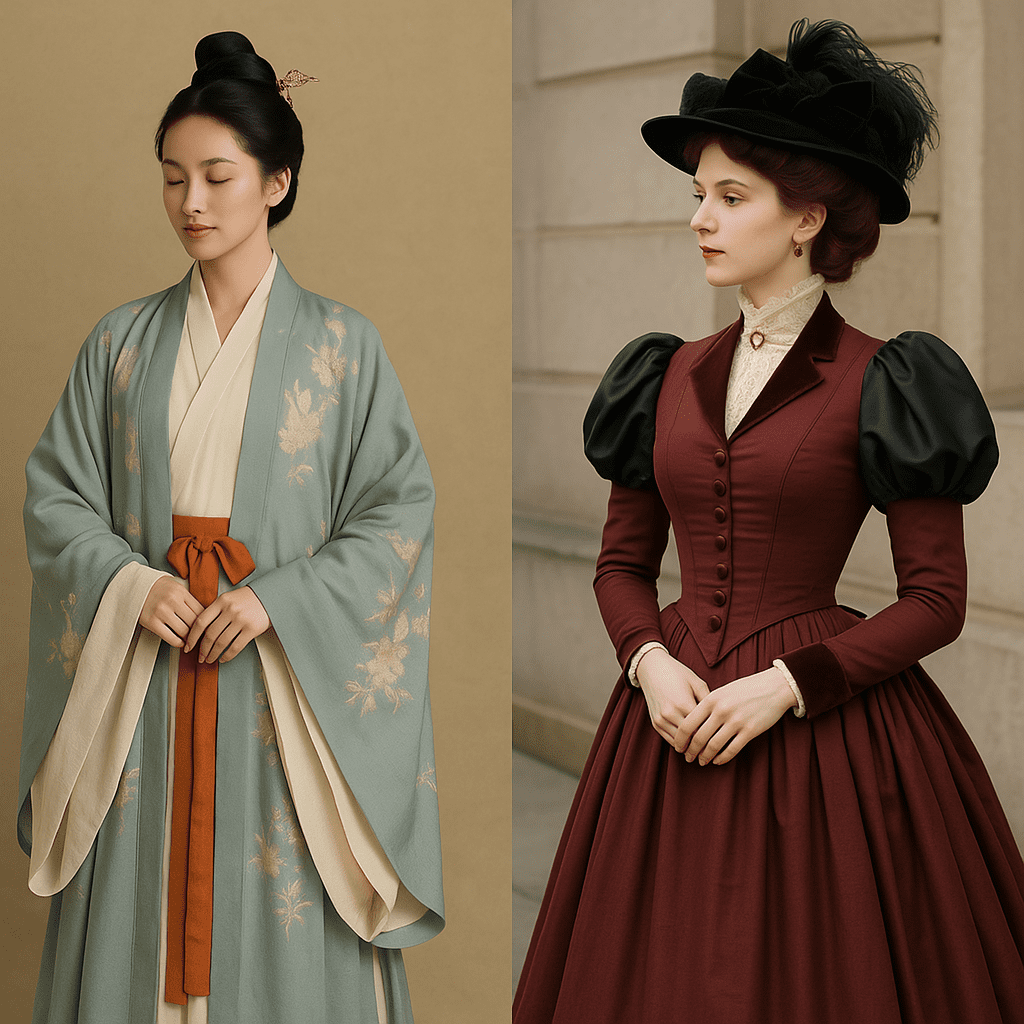Hanfu vs Victorian Fashion: Elegance from East and West

When it comes to historical fashion, both China and the West have produced unforgettable silhouettes that defined entire eras. Two of the most iconic traditional clothing styles—Hanfu from ancient China and Victorian fashion from 19th-century Britain—represent the highest points of elegance and symbolism in their respective cultures.
While they developed oceans apart, these two styles share surprising similarities in their aesthetic ambitions, cultural meanings, and even the way they’re being revived today.
Let’s explore a side-by-side comparison of Hanfu and Victorian fashion—what they reveal about history, beauty, and identity.
1.Origins and Philosophy
Hanfu refers to the traditional clothing worn by Han Chinese for over 3,000 years, dating back to the Zhou dynasty. It’s more than just a fashion statement; Hanfu reflects Confucian ideals, ritual propriety, and the harmony between man and nature. Clothing followed strict rules depending on your role, age, or occasion, emphasizing inner cultivation through outer elegance.
Victorian fashion, on the other hand, flourished during Queen Victoria’s reign (1837–1901), a time of industrial revolution and moral strictness in Britain. The clothing reflected social hierarchy, gender roles, and modesty—with an emphasis on formality, structure, and social decorum.
Despite different origins, both styles served a similar purpose: to communicate cultural values and reinforce social order through dress.
2.Silhouette and Structure
Hanfu silhouettes are known for their flowing lines, wide sleeves, and layered robes. There is little to no tailoring in the Western sense—everything drapes naturally, creating a sense of grace and airiness. The fabrics move with the body like water, often paired with sashes or long ribbons to add movement.
Victorian clothing emphasized the opposite: structure and shape. Corsets cinched the waist to achieve the coveted “hourglass” figure, while bustles and petticoats created dramatic volume in the skirts. Fabric was tailored, pleated, and layered with heavy detail—lace, buttons, and trims were essentials.


3. Materials and Patterns
Both styles celebrated craftsmanship and beauty in textiles.
Hanfu often uses silk, featuring subtle embroidered patterns like cranes, clouds, or flowers, each symbolizing something deeper (longevity, peace, elegance). Colors were also symbolic: red for weddings, white for mourning, and certain shades reserved for royalty or scholars.
Victorian garments also featured fine fabrics, including silk and velvet, but with an emphasis on richness and decoration—floral prints, tartans, and lace. Embroidery was a mark of wealth, and black became a popular color especially after Queen Victoria’s long mourning period.
4. Gender and Social Roles
Hanfu designs for men and women both followed the same aesthetic logic—long robes, symmetry, and elegance—though with some shape and sleeve differences. The style was not overtly sexualized; modesty was seen as virtue for all genders.


Victorian fashion, however, created sharp gender contrasts: women wore layers of constricting garments, while men donned suits and top hats. Women’s fashion emphasized frailty and delicacy; men were expected to appear upright, proper, and rational.
5. Modern Revival and Global Interest
Both Hanfu and Victorian fashion have seen modern revivals, but in different ways:
The Hanfu Movement in China has grown rapidly since the early 2000s. Young Chinese people wear Hanfu in everyday life, at festivals, or for photography, as a way to reconnect with heritage.
Victorian fashion has inspired Gothic, Lolita, and Steampunk subcultures in the West. Corsets, lace gloves, and parasols are reimagined with fantasy elements, blending past and future aesthetics.
Interestingly, Hanfu is now gaining global fans, including in Western cosplay, fashion, and cultural circles. As fashion becomes more global, people are drawn to stories, not just styles—and Hanfu tells a rich, poetic story of its own.
6. Final Thoughts
Hanfu and Victorian fashion are two beautiful expressions of human creativity across different continents. One flows like a river; the other stands like architecture. One emphasizes natural harmony; the other, societal structure. But both tell us that clothing is never just fabric—it’s identity, culture, and art.
As we move further into a connected world, perhaps it’s time for a new conversation—not just about East vs. West fashion, but how we can borrow, respect, and celebrate the best of both.





Responses